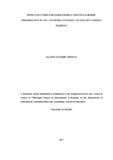| dc.description.abstract | There is need for research to find out the instructional effectiveness of computer based instruction in the teaching of Art and Design in public secondary schools in Kenya. The purpose of the study was to find out the extent to which computer based instruction could improve learner’s performance in Art and Design in Kenya’s secondary schools. The main objective of the study was to find out if there is any significant difference on learner’s performance in Art and Design after they were exposed to computer based instruction and those who were not exposed. Gender and school categories were also examined to find out if they had any significant effect on learner’s performance after CBI was used to teach Art and Design. This is because, in the last six years, learners’ performance in the subject has been on the decline KNEC 2008; 2009; 2010; 2011; 2012; 2013; 2014. The study investigated three instructional methods; computer based instruction (CBI), conventional methods of instruction (CM) and combined methods of instruction (CMI) in the teaching of graphics in Art and Design. The study further explored possible gender influence on students’ performance after learning graphics in Art and Design using the three modes of instruction. School category was examined to find out if it affected learners’ performance. The study design was quasi-experiment of the nonequivalent control design. The target population for the study were Form two students doing Art and Design and their subject teachers. Nine boys’ and nine girls’ schools were used in the study, a total of eighteen public secondary schools in ten Counties in Kenya. Four hundred and fifty students and eighteen teachers were respondents in the study. The treatment groups had three hundred students while control groups had one hundred and fifty students. Each treatment group had three schools which were either in CBI or CMI. There were also two control groups, consisting three boys’ CM and three girls’ schools CM. The research instruments used to collect data for this study were two: Art and Design performance tests (ADPT)1and (ADPT)2 (pre-test, post-test), teachers’ and students’ questionnaires. Data analysis was done with the help of a computer programme SPSS for statistical analysis. The study found that there is a significant difference in the three modes of instruction. Learners who were taught graphics in Art and Design using CBI showed the most improved performance followed by those who were taught using CMI, but the learners taught using CM showed the least improved performance. This study also found that gender had a significant effect on performance of the learners using the three modes of study. The study also found that the topic on graphics design at the secondary school level in Kenya was poorly done because students lack accuracy and creativity due to inadequate time for practice and exploration. Further the study found out that use of computer-based instruction in schools is constrained by lack of enough personal computers that would encourage individual instruction, lack of computer programmes that are employable in Art and Design and unavailability of internet. Low level of computer literacy among Art and Design teachers confined them to give instruction using traditional methods. The study recommended that, a strong support at the national level be initiated towards a systematic planning for the use of technology in the schools through improving facilities, equipments and training of the Art and Design teachers to gain computer skills. | en_US |



